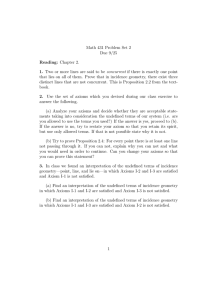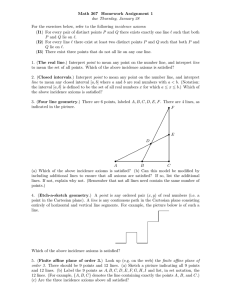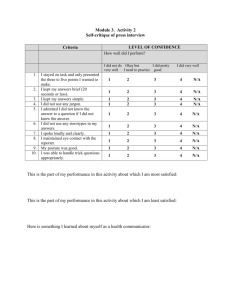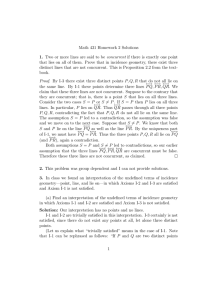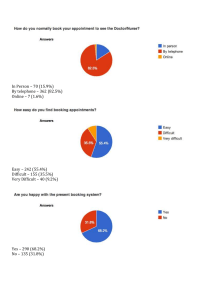Math 431 Solutions to Homework 3
advertisement
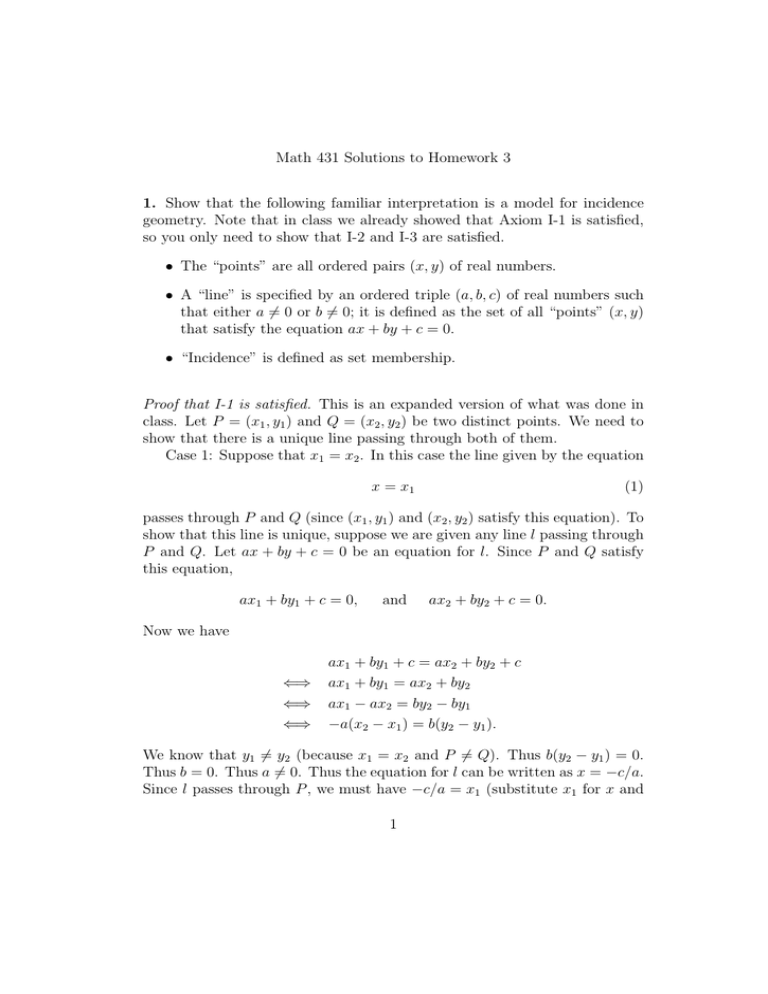
Math 431 Solutions to Homework 3
1. Show that the following familiar interpretation is a model for incidence
geometry. Note that in class we already showed that Axiom I-1 is satisfied,
so you only need to show that I-2 and I-3 are satisfied.
• The “points” are all ordered pairs (x, y) of real numbers.
• A “line” is specified by an ordered triple (a, b, c) of real numbers such
that either a 6= 0 or b 6= 0; it is defined as the set of all “points” (x, y)
that satisfy the equation ax + by + c = 0.
• “Incidence” is defined as set membership.
Proof that I-1 is satisfied. This is an expanded version of what was done in
class. Let P = (x1 , y1 ) and Q = (x2 , y2 ) be two distinct points. We need to
show that there is a unique line passing through both of them.
Case 1: Suppose that x1 = x2 . In this case the line given by the equation
x = x1
(1)
passes through P and Q (since (x1 , y1 ) and (x2 , y2 ) satisfy this equation). To
show that this line is unique, suppose we are given any line l passing through
P and Q. Let ax + by + c = 0 be an equation for l. Since P and Q satisfy
this equation,
ax1 + by1 + c = 0,
and
ax2 + by2 + c = 0.
Now we have
⇐⇒
⇐⇒
⇐⇒
ax1 + by1 + c = ax2 + by2 + c
ax1 + by1 = ax2 + by2
ax1 − ax2 = by2 − by1
−a(x2 − x1 ) = b(y2 − y1 ).
We know that y1 6= y2 (because x1 = x2 and P 6= Q). Thus b(y2 − y1 ) = 0.
Thus b = 0. Thus a 6= 0. Thus the equation for l can be written as x = −c/a.
Since l passes through P , we must have −c/a = x1 (substitute x1 for x and
1
y1 for y). We started with an arbitrary line l passing through P and Q and
concluded that in fact l is given by Equation (??). This proves the uniqueness
of l.
Case 2: Suppose that x1 6= x2 . One can check by substitution that the
line given by the equation
y2 − y1
· (x − x1 )
(2)
y − y1 =
x2 − x1
passes through P and Q. To prove uniqueness, suppose that l is any line
passing through P and Q. Let ax + by + c = 0 be an equation for l. The
same calculation as in Case 1 gives us
−a(x2 − x1 ) = b(y2 − y1 ).
Since x1 6= x2 , we have b 6= 0 (if b = 0 then a = 0, which is not allowed by
our definition of a line). Thus
a
y2 − y1
.
− =
b
x2 − x1
Now the equation for l can be written as
c
y2 − y1
·x− .
y=
x2 − x1
b
(3)
Plugging in (x1 , y1 ) gives
y1 =
y2 − y1
c
x1 −
x2 − x1
b
or equivalently
−
c
y2 − y1
= y1 −
x1 .
b
x2 − x1
Substituting this expression for −c/b into Equation (??) and rearranging
terms shows that the equation for l is equivalent to Equation (??). This
proves the uniqueness of l.
Proof that I-2 is satisfied. Let l be any line in R2 having equation ax + by +
c = 0. We will find two points on l.
Case 1: Suppose that b = 0. Then the equation for l may be written as
x = −c/a. Two points lying on l are (−c/a, 0), (−c/a, 1). (Any point of the
form (−c/a, y) would work.)
Case 2: Suppose that b 6= 0. Then the equation for l may be written as
y = −a/bx − c/b. Two points lying on this line are (0, −c/b), (1, −a/b − c/b).
(Any point of the form (x, −a/b · x − c/b) would work.)
2
Proof that I-3 is satisfied. We claim that the three points (0, 0), (0, 1), (1, 0)
do not all lie on the same line. In verifying I-1 we saw that there is only one
line passing through (0, 0) and (1, 0), and its equation is y = 0. This line
does not pass through (0, 1) since (0, 1) does not satisfy the equation y = 0.
Thus, no line can pass through all three of these points.
Recall that a statement in an axiomatic system is independent if it is not
a theorem and its negation is not a theorem. To conclude that a statement
S is independent, you need to find a model that satisfies S and a model
that does not satisfy S. In problems 1, 2, and 3, you are given a statement
S. For each problem, decide if (a) S is a theorem in incidence geometry;
(b) not-S is a theorem in incidence geometry; or (c) S is an independent
statement in incidence geometry. Provide justification (give a proof or supply
the appropriate models). You may quote results that were proved in class or
on homework. Remember that when giving a model, you should check that
it satisfies the axioms.
2. There exist four distinct lines.
Solution: This statement is independent. As justification, we provide two
models: one that satisfies the statement and another that does not.
Model 1: There are exactly four “points” A, B, C, D. The “lines” are all
sets of two points, {A, B}, {A, C}, {A, D}, {B, C}, {B, D}, {C, D}. “Lie
on” means set membership.
This is the four-point model discussed in class and in the textbook on
pages 54-55. We claim that this is a model that satisfies the statement
“there exist four distinct lines”.
To see that our interpretation is actually a model for incidence geometry,
we have to check that the incidence axioms are satisfied. I-1 is satisfied
because for any two distinct points X, Y ∈ {A, B, C, D}, according to our
model the only line passing through them is {X, Y }. I-2 is satisfied because
every line {X, Y } by definition has two points X and Y lying on it. I-3 is
satisfied because there is no two element set that contains all three points
A, B, C, so these three points are not all on the same line.
We also have to verify that the statement “there exist four distinct lines”
is true in our model. Well, here are four distinct lines: {A, B}, {A, C},
{A, D}, {B, C}. Thus the statement is satisfied.
3
Remark 1: Since I-3 is a “there exists” statement, you only need to find
three particular points, say A, B, C, that are not collinear; you should not
try to show that every three points are not collinear. By contrast, you need
to check that in your model, I-1 is true “for every two points” and I-2 is true
“for every line”.
Remark 2: “There exist four distinct lines” means the same thing as
“there exist at least four lines,” so any model with four or more lines, such
as the Cartesian plane, satisfies this statement.
Model 2: There are exactly three “points” A, B, C. The “lines” are the sets
of two points {A, B}, {A, C}, {B, C}. “Lie on” means set membership.
This is the three point model discussed in class and in the textbook on
page 52, Example 1. The verification of the axioms is carried out in the
book, so this really is a model. There are only three lines in this model, so
the statement “there exist four distinct lines” is not satisfied.
3. There exists a point such that at most one line passes through it.
Solution: The negation of this statement is a theorem. The negation is
For any point there are at least two lines passing through it.
This is Proposition 2.5 from the textbook. If we haven’t given a proof already,
let me know and I will write one up.
4. For any three distinct lines l, m, and n, if l k m and n ∦ l, then n ∦ m.
Solution: This statement is independent. As justification we give two models: one that satisfies the statement and another that does not.
Model 1: The standard three-point model (discussed in the previous problem)
satisfies the statement. This is because there are no parallel lines in the
three-point model, so the “if” part of the statement is always false, making
the “if-then” statement always true.
Model 1 (alternative): Use the four-point model from the previous problem.
We already know it is a model, so we won’t verify the axioms again.
It remains to show that the statement given in the problem is satisfied.
Suppose we have three (distinct) lines l, m, and n in our model. To be
more specific, let us say l = {P, Q} and m = {R, S} where P, Q, R, S ∈
{A, B, C, D} (we used new names P, Q, R, S because we do not know which
pair of points is on l and which pair is on m; these new names allow for
4
the possibility that P = A or P = B or P = C or P = D, for example).
Assume further that l k m and n ∦ l. We want to show that n ∦ m. Since
l k m, these two lines have no point in common, so P, Q, R, S must be four
distinct points. Since n ∦ l, n has a point in common in l by definition of
parallel. We also know by Proposition 2.1 that this point is unique. Without
loss of generality, say that this common point is P . (We actually do not
know that this point is P ; it could possibly be Q. By saying “without loss
of generality”, we are indicating that the argument we are about to give will
apply just as well to Q.) Now that we know P is one of the points on n, the
other point on n must be either R or S (it cannot be Q because then by the
uniqueness part of I-1, n would equal l, contrary to our assumption that the
three lines are distinct). In either case, n will have a point in common with
the line m = {R, S}, so n is not parallel to m.
Remark: Students were not expected to give a proof with this much
detail. When reasoning with models in this course, we will generally not be
able to give proofs from first principles, because the underlying assumptions
have not been completely laid out. For example, we have not discussed
axioms for the real numbers, so our proofs involving real numbers, detailed
as they seem, will not be as complete as our proofs in axiomatic geometry.
On the other hand, the proof we just gave merely involved a set of four
points; there is less to take on faith in trying to comprehend what a set of
four points is compared to, say, what the real numbers are.
Model 2: There are exactly five points in our model: A, B, C, D, E. The lines
are the sets consisting of exactly two points (there are 10 lines total). “Lie
on” will mean set membership.
We wish to show that our model does not satisfy the statement in the
problem; that is, our model satisfies the negation of the statement:
There exist three lines l, m, and n such that l k m, l ∦ n, and
n k m.
It suffices to find three lines that have the properties specified in the statement. Here are three such lines: l = {A, B}, m = {C, D}, n = {A, E}.
5. An affine plane is a model for incidence geometry having the Euclidean
parallel property: For every line l and every point P not on l, there exists
exactly one line through P that is parallel to l.
5
Prove that in an affine plane, for any three distinct lines l, m, and n, if
l k m and n ∦ l, then n ∦ m. (Thus, the statement given in problem 3 is a
theorem in affine geometry.)
Proof. Let l, m and n be three distinct lines. Suppose that l k m and n ∦ l.
Since n ∦ l there is a point P that lies on both n and l. Note that P is not
on m since l and m have no points in common. By the Euclidean parallel
postulate there is only one line through P that is parallel to m. Since n and
l are two different lines passing through P and l is parallel to m, n must not
be parallel to m.
6

